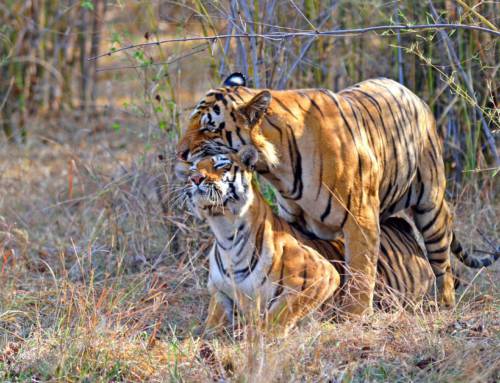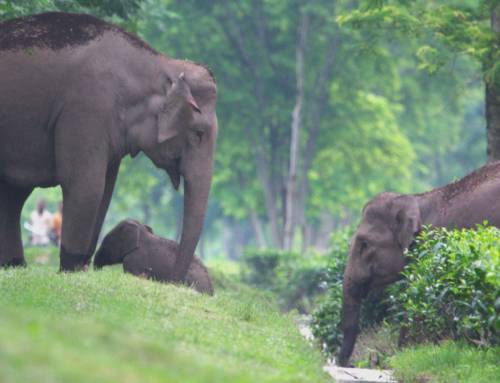Research Article: Prasad, S., Aditya, V., Solomon, J. et al. Community mitigation decisions in elephant conflict zones of southern India depend on environmental and socio-economic drivers. Sci Rep 15, 34693 (2025). https://doi.org/10.1038/s41598-025-14867-3
Blog Author: Simran Prasad
Key highlights:
- Scientists surveyed 507 rural households across Karnataka and Kerala to understand community decision-making drivers on human–elephant conflict mitigation.
- The study identified that commonly used barriers were causing unintended harm to elephants. Trenches accounted for 12.8% of elephant injuries in Karnataka, while solar fences in Karnataka (25.5%) and electric fences in Kerala (38.3%) caused most of the 47 reported elephant deaths.
- Households located in drier areas with moderate landholdings were 68% more likely to adopt mitigation, while those living in wetter regions, with larger, water-adjacent plots, had only a 7% likelihood of mitigation deployment. Rainfall, elevation, land size, and crop type were the strongest predictors of these decisions.
- Despite the conflict, communities expressed grief and sadness for elephants lost or injured, highlighting their cultural association and bond with the species.
- Communities recommended multiple solutions, also highlighting the need for safe, non-lethal, and proactive solutions.
- The authors suggest early warning systems, night patrols, and regenerative farming as proactive measures to tackle conflict.
Globally, human–wildlife interactions have occurred for centuries. These interactions can often evolve into negative, hostile interactions, known as human–wildlife conflict, which can threaten people and wildlife. Consequently, conflict can have serious impacts, causing severe damages to people, i.e, crop and property loss, livestock depredation, injury, and human death. Alternatively, conflict damages can significantly impact elephants, resulting in contraction of their habitat and increased conflict with people.
To examine community decision-making for mitigation measure deployment, the authors conducted the study across Karnataka and Kerala, focusing on the areas surrounding Bandipur and Nagarahole Tiger Reserves in Karnataka and Palakkad and Mannarkkad Territorial Forest Divisions in Kerala. These areas are located within the Western Ghats, a global biodiversity hotspot encompassing an estimated area of 160,000 km². A questionnaire survey was conducted with 507 respondents across the study site to ascertain community decision-making and recommendations for mitigation measures. The results highlighted two distinct decision paths for mitigation measure deployment that emerged from the analysis. First, the decision tree revealed that households in areas affected by low and moderate rainfall (1000 – 2333 mm) and owning a minimum of 0.075 acres of land are 68% more likely to deploy mitigation measures. Contrastingly, respondents living in areas with high rainfall (>2334 mm), larger landholdings (>2.8 acres), and closer to water bodies (within 7.2 km) are only 7% likely to deploy mitigation measures. The authors also analyzed elephant injury and death patterns due to mitigation measures, and identified that there were 8 observations of elephant injuries and 47 reported elephant deaths across both States. Findings from the thematic analysis of community responses also revealed that 87 respondents expressed sadness upon seeing an injured/deceased elephant. People also expressed empathy (36 respondents) and pity for elephants (28 respondents). There were also recommendations for mitigation measures, i.e, railway line fencing (105 respondents), solar fencing (95 respondents), and night guarding/patrolling (17 respondents).
The authors emphasize that their findings highlight the variability of conflict in dynamic landscapes and the need to focus on non-lethal, preventative conservation measures, such as warning systems and the use of artificial intelligence (AI) with thermal infrared cameras for biodiversity monitoring in densely human-populated areas. In addition, the authors also discuss environmental solutions, such as regenerative farming and agroforestry practices that can help habitat connectivity for elephants and mitigate climate change impacts. These habitat restoration efforts can also be focused on fragmented landscapes of the Western Ghats to potentially strengthen habitat corridors across state boundaries.
Projected human population numbers are estimated to grow to 9.77 billion by 2050, endangering people and wildlife, especially in conflict-prone areas. Addressing these challenges cohesively requires working with local communities to gain a deeper understanding of community perspectives, whilst integrating technological innovations in an environmental context. These solutions can drive change to balance the needs of people and elephants in shared landscapes.
You can access the original article here.
Keywords: Elephas maximus, Human-wildlife interactions, Community decisions, Perspectives, Conservation interventions, Mitigation measures




